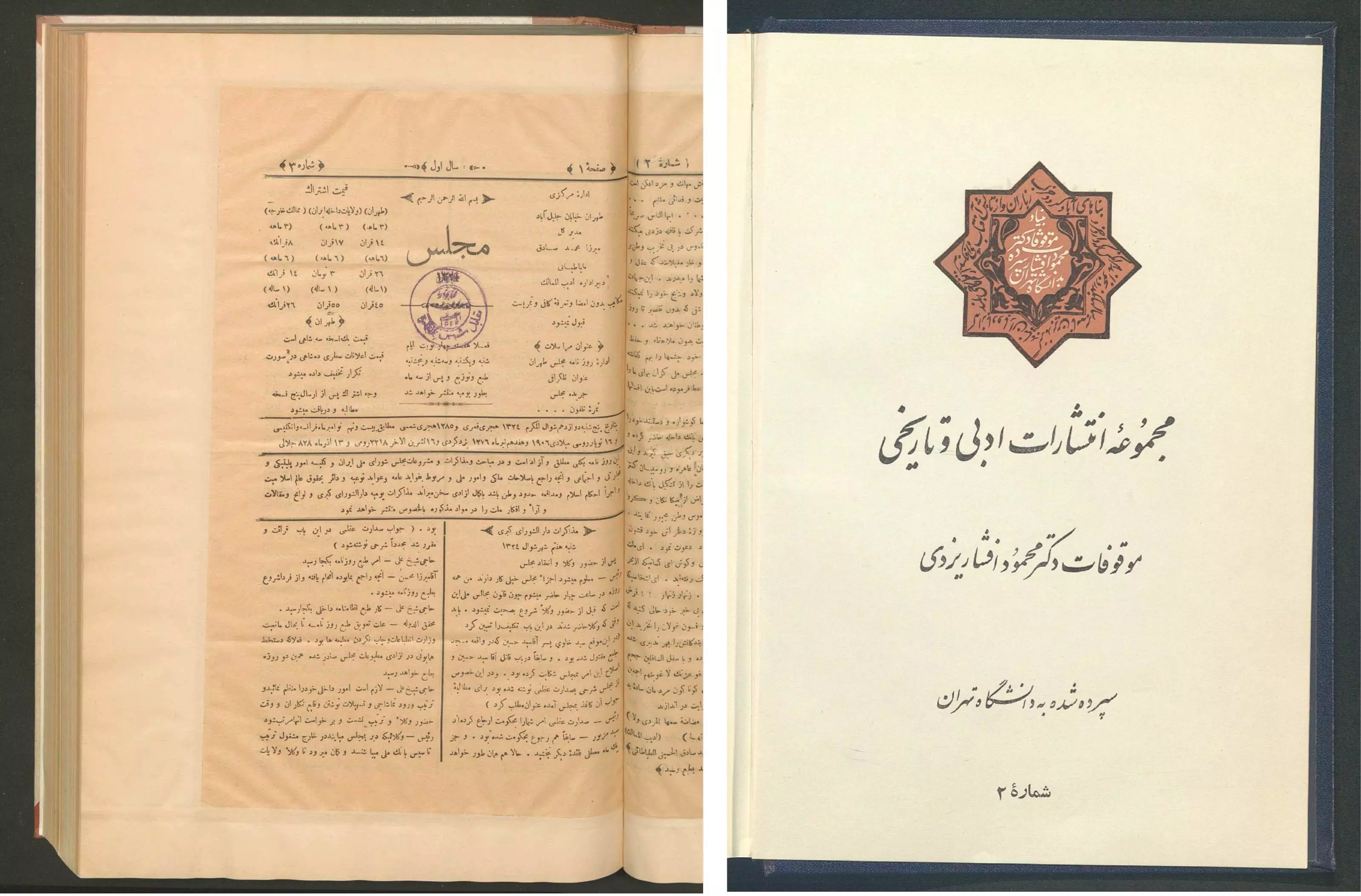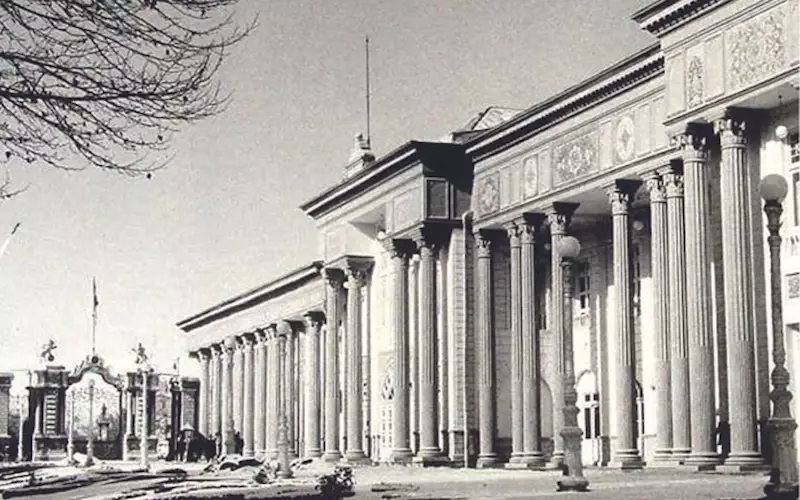Print History: Iranian printing in 1930 - Matba Mejlis
Persia was experiencing an efflorescence in the 1930s as a new ruling dynasty tried to fast forward the country towards modernity. How could the printing sector be left behind?
31 Jul 2022 | By Murali Ranganathan
Connections between the western coast of India and Persia go back to prehistory with a constant traffic of people and goods between the two countries. The connection between North India and Persia over the land route was equally strong. By the sixteenth century, Persian had become the language of diplomacy and government in large parts of India. Persian retained its status as the official language of India until the 1830s.
From the ninth century, Zoroastrian refugees began to arrive in large numbers from Iran and settled in south Gujarat. Over the centuries, they managed to retain their distinct identity and were known as Parsis. As the situation in Persia became increasingly hostile to their religion, the connection with Persia diminished considerably. In the nineteenth century, a fresh wave of Zoroastrians arrived in India from Persia, largely as economic refugees, and carved a distinct identity as Iranis.
As the Parsis of India tried to help them and their families who were still in Persia, the connection between Bombay and Persia began to intensify once again. The Parsis contributed significant amounts of money for the revitalisation of the Zoroastrian community in its traditional strongholds of Yazd and Kerman and funded the establishment of community schools and the revival of religious institutions. By the 1920s, groups of Parsis were visiting Persia to see for themselves the changes wrought by their involvement and to determine the extent to which they could involve themselves in a country which seemed to be in the throes of change.
This period also saw political turmoil in Persia with the Constitutional Revolution (1905–11) that eventually led to the establishment of a Parliament or Mejlis in Iran. This was followed by the military upheaval (1921–25) that led to the ruling Qajar dynasty being replaced by the Pahlavi dynasty. Under the Qajars, the Zoroastrians and other religious minorities of Iran were treated as second-class citizens. But Reza Shah Pahlavi, the new monarch, adopted an official policy of religious non-discrimination. He was particularly solicitous of the Parsis of India and lost no opportunity to invite them to invest in infrastructure and industries in Persia.
Travel to Persia
One of the Parsi groups which visited Iran in 1930 included the Anklesarias of Bombay who had a close connection to printing. The family owned the Fort Printing Press, one of the leading Parsi printing presses of its time in the city. It specialised in printing Zoroastrian religious texts, in the original Avestan and Pahlavi languages and scripts, along with translations and explications in Gujarati and English.
The Fort Printing Press was famous for the elegance of its Avestan and Pahlavi type. It had been founded in the 1870s by Tehmuras Dinshaw Anklesaria (died 1903) who was not only a printer but also a scholar of Pahlavi literature. After his death, the printing press passed on to his younger son Hoshang while his elder son Behramgore spent a lifetime researching the history of Zoroastrianism and its literature. Behramgore’s wife Meherbanu also accompanied him on the visit to Iran.
Title page, Pahlavi Iranma Musafari by Meherbanu Behramgore Anklesaria (Mumbai: Fort Printing Press, 1932)
After returning to Bombay, Meherbanu Anklesaria wrote a detailed travelogue titled Pahlavi Iranma Musafari (Travels in Pahlavi Iran) which was published by the Fort Printing Press in 1932. Her book was the sixth Iran travelogue to be published in the Gujarati travelogue within a decade and the second to be written by a woman after Kunvarbai Dhalla’s account which was published in 1923. Within a decade, Iran had been transformed: the primary mode of transport had been mule and donkey in the early 1920s, but by 1930, automobiles were ubiquitous. A network of motorable roads criss-crossed the inhospitable terrain and shortened journeys from weeks to days. Where earlier the highways had been infested by bandits and travellers were forced to travel in large caravans for safety, there was now peace and security on the roads.
Like other travellers, the Anklesarias covered the major cities—Isfahan, Shiraz, Yazd, Kerman, Tabriz—and the historical sites associated with ancient Iranian dynasties such as Persepolis and Behistun. However, they stayed in Tehran for an extended period and used it as their base to explore other parts of the country.
At Tehran, they were hosted by Arbab Kaykhosrow Shahrokh (1874–1940), perhaps the most influential Zoroastrian in Iran at that time. Arbab Kaykhosrow was a member (or Deputy) of the Iranian Mejlis representing the Tehran Zoroastrian Anjuman. He also had executive responsibilities in the Iranian government and was effectively the custodian of the Mejlis building in Baharestan Square.

During their stay in Tehran, the Anklesarias made multiple visits to the Mejlis building in the company of Arbab Kaykhosrow. Meherbanu devotes an entire chapter in her travelogue to their Mejlis visits. After noting that the Mejlis had 136 deputies or members and a cabinet of ten ministers, she remarks that “Arbab Kaykhosrow played the key role in the construction of the Mejlis building and fitting it out with the required furniture.” He had been a member of the Mejlis for the previous twenty-two years and enjoyed the trust and confidence of His Majesty Reza Shah and the Mejlis.
A visit to Matba Mejlis
The highlight of the visit was the printing press which functioned inside the Mejlis building. In some of its imprints, the press is referred to as Chhapkhana Mejlis while in others it is Matba Mejlis.
We next went to see the Matba Mejlis. The press is chock-a-block with German machinery of the latest make. They seem to have everything: from machines for filing and shaping to lathes for turning, facilities for minor repairs in the printing presses, machines for automatically ruling paper, the current models of Linotype typecasting machines, types for printing in Latin, Russian, Armenian, Persian, Avesta, and Pahlavi scripts, a photo studio for photozincography, block-making and printing, and most importantly the ability to print postal and revenue stamps, and three-colour printing.
The credit for ensuring that the printing press is up-to-date with recent trends undoubtedly goes to our Zoroastrian Deputy Arbab Kaykhosrow Shahrokh. An electric dynamo has been installed to provide the electricity needed to power the press. Though a German technical manager oversees the operation of the machines, all the other employees are Iranians, of whom eighteen are Zoroastrians.
The Matba Mejlis had been founded in 1906 under the supervision of Mirza Syed Mohammad Sadiq Tabatabaei who also edited Mejlis, the mouthpiece of the Iranian parliament between 1906 and 1908. Arbab Kaykhosrow was appointed by the Mejlis as the director of the Matba Mejlis in 1909, a position he held until 1939. During these thirty years, Persia saw numerous revolutions but Arbab Kaykhosrow managed to survive them all and retained a position of influence. The printing press was transferred to the new Mejlis building in 1911. By the mid-1920s, most of the machinery in the Matba Mejlis had become outdated and worn out. It was completely modernised in 1927 by Arbab Kaykhosrow with funds sanctioned by the Mejlis.

Arbab Kaykhosrow Shahrokh (1874–1940)
The Matba Mejlis effectively became the state press of Iran and undertook all the security printing on its behalf. The press employed 110 workmen in 1930 which increased steadily to around 250 by the end of the decade. As someone who was well aware of trends in printing technology, Meherbanu was particularly impressed by the investments made in the latest German machinery which had enabled Iran to leapfrog India in terms of printing capability.
It is said that our Hindustan entered the age of modernity about a century and a half ago but it is only in the last three to four years that the printing of stamps started in our country. On the contrary, it is just over five years since the Pahlavi dynasty was established in Iran, but postage stamps in a variety of colours portraying the visage of His Majesty have been issued for the last three years. The sales of these stamps have generated an annual revenue of about fifty thousand tumans or one and half lakh rupees and augmented the finances of Iran.
This is the result of a genuine sense of purpose to serve the country and improve its fortunes. It is indeed praiseworthy that, notwithstanding centuries of misrule and abuse by foreign powers, the Iranian population have managed to preserve their spirit of independence and the ability to move forward under the newly reformed system.
Exaggerated praise for the Pahlavi regime and its modernising ways was a constant refrain among the Parsis of India during this period as they tried to feel their way in a rapidly changing world where their traditional secure position in Indian society could come under threat, especially with the already-foretold end of colonial rule. The fact that a fellow Zoroastrian was the architect of the Matba Mejlis perhaps coloured Meherbanu’s perceptions. However, there was no denying that the Matba Mejlis had made rapid strides in the world of printing. Meherbanu describes some of the print artefacts that were shown to them.

Periodicals printed at Matba Mejlis: Mejlis (1906) and Ayanda (1925)
We saw an album with a beautiful morocco leather binding which contained a few printing samples produced at the Matba Mejlis. It included coloured photographs of His Majesty Reza Shah, the Crown Prince, the Minister of Court, the President of the Mejlis, and other notables. Other print samples included the entire variety of stamps, cheques, and share certificates printed at the press. Another album with a similar binding contained print specimens of the approximately 480 typefaces used to print in a variety of languages. Specimens of three-colour work and other examples from the printing press were also shown to us. Of course, German supervisors trained the Iranians in the initial years, but now all the work is done by Iranian supervisors and workers.
Considering the progress they have made in the last five years, they are certainly deserving of high praise. Erecting such a large printing press in such a short time with all these departments to match any up-to-date European press calls for superior management and a lot of hard work. Moreover, the huge sum invested in this printing press has been recovered in less than three years of operation because of astute business practices. It is hoped that, in the years to come, the printing press will yield annual profits running into thousands of rupees.

Books printed at Matba Mejlis: Siyasat Nama (1942) and Ahang Haye Muhalli (1945)
Imprints and legacy
Besides printing the eponymous Mejlis in its initial years, the Matba Mejlis printed many other periodicals including the Roznama Tamaddun, Mamaat va Hayat, and Ayanda (a literary monthly founded in 1925). It also published a large number of books including textbooks and government laws. As the influence of France increased in Iran, a number of bilingual books were published in French and Persian. The Matba Mejlis survived into the 1950s and beyond. The printing machines and paraphernalia of the Matba Mejlis are still preserved in the original site which is now known as the old Parliament building.















 See All
See All